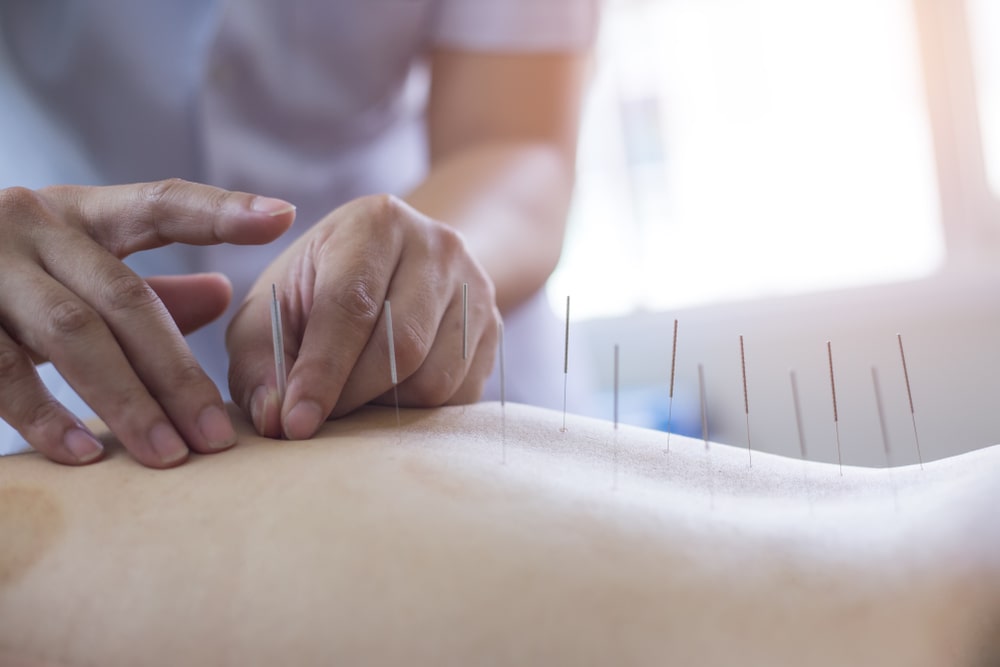Acupuncture, dry needling, intramuscular stimulation. You’ve heard of these before, right? Most people have heard a miraculous story from a co-worker, family member or a friend of a friend following a needling treatment. Surprisingly to some, needling is not the new treatment on the block. In fact, acupuncture has been around for thousands of years. Dry needling on the other hand is a relatively newer technique that may be utilized by physiotherapists. So, what is dry needling and what is the theory behind its outcomes? Read on to find out!

Needling pain relief in Calgary
Acupuncture vs Dry Needling
Sterile, fine filiform needles are used in both acupuncture and dry needling techniques. Both methods aim to decrease pain and increase function. However, that is where their similarities end. In a nutshell, acupuncture originates from Traditional Chinese Medicine and treatment is based on the flow of qi and energy meridians. Dry needling is derived from Western Medicine and needles are inserted based on theories involving neuromuscular dysfunction.
What is Trigger Point Dry Needling?
There are several dry needling techniques that are based on different models, such as the radiculopathy model and the trigger point model. Trigger point dry needling is a skilled intervention used by qualified professionals to treat myofascial pain disorders. A sterile acupuncture needle is inserted in to the tissues to target myofascial trigger points; or in simpler terms, hyper-sensitive knots in the muscle. There are two types of trigger points that may be targeted: active and latent. Active trigger points may spontaneously cause local or referred pain, while latent only cause pain if they are stimulated. For example, the knot in your shoulder that is continuously painful is active. The shoulder knot that shoots pain in to your upper back with pressure is latent.
Dry needling improves the affected area by increasing oxygen and blood flow, favorably changing the biochemical environment and improving muscle fiber length. Together, these outcomes result in decreased local and referred pain.
Does Dry Needling Hurt?
Ever had a “Charley horse” or an intense muscle cramp before? Following needle insertion in to a trigger point, a similar sensation called a local twitch response often occurs. Although this cramping is uncomfortable, it is generally short lived. After completing a dry needling treatment, it is likely that the treated areas will feel sore for the remainder of the day and possibly the following day. You may wake up feeling as though you crushed a tough workout at the gym until you remember that you didn’t go to the gym yesterday, you went to your local sports physiotherapist.
Cramping and soreness are common descriptions of pain associated with needling but it is important to remember that pain is subjective and each person may react differently depending on their tolerance to the treatment.
Dry Needling and Physiotherapy
In physiotherapy, dry needling is utilized as an adjunct treatment. This means that if you are having needles inserted during a session, they are likely utilized as a fraction of your personalized treatment program. Dry needling may also be combined with a healthy dose of education, tailored exercises, pain management advice and even manual therapy. It is used by clinicians to help improve symptoms in many conditions including, but not limited to:
- Lower back pain
- Rotator cuff injury
- Headaches
- TMJ dysfunction
- Tennis elbow
- Knee Osteoarthritis
- Carpal tunnel syndrome
If dry needling sounds like something that you may benefit from, booking an appointment with your local physiotherapist is a great place to start. They will be able to provide further education on how dry needling can assist you toward your own unique rehabilitation goals.
Dry needling is not a magical one-time-fix-all treatment as many people are led to believe. That being said, it can offer quick results that may be maintained with simple exercises to improve your level of function.
At Panther Sports Medicine clinics, many of our sports physiotherapists are trained in dry needling, as well as various other forms of therapy from which you may benefit. Visit one of our locations in Calgary, and let us help you move better!
Written by: Kirsten Holte, MScPT
References
Dommerholt, J., Del Morel, O. and Grobli, C. (2006) Trigger Point Dry Needling. The Journal of Manual and Manipulative Therapy, 70-87.





